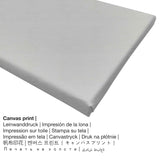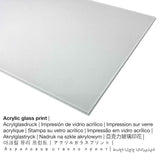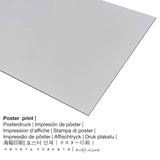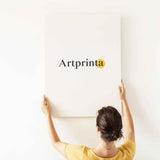Thomas Gainsborough, 1785 - Portrait of William Anne Hollis, 4th Earl of Essex - fine art print
Tax included. Shipping calculated at checkout.
Portrait of William Anne Hollis, 4th Earl of Essex is a piece of art by the rococo British artist Thomas Gainsborough in 1785. Moveover, this artpiece belongs to the The J. Paul Getty Museum's digital collection in Los Angeles, California, United States of America. With courtesy of - The J. Paul Getty Museum (license - public domain).: . In addition to that, the alignment of the digital reproduction is landscape with an aspect ratio of 1.2 : 1, meaning that the length is 20% longer than the width. The painter Thomas Gainsborough was an artist from the United Kingdom, whose style can be attributed mainly to Rococo. The British artist lived for a total of 61 years and was born in the year 1727 in Sudbury, Suffolk, England, United Kingdom and passed away in 1788.
Product materials our customers can pick
For every product we offer a range of different sizes & materials. The following sizes and materials are the options we offer you for individualization:
- Acrylic glass print (with real glass coating): A glossy acrylic glass print, often denoted as a UV print on plexiglass, makes your chosen original work of art into lovely décor. The work of art is made with the help of state-of-the-art UV direct print machines. This creates the impression of sharp, vibrant colors.
- The poster print (canvas material): A poster is a printed canvas paper with a nice surface finish, that reminds the original work of art. Please bear in mind, that depending on the absolute size of the poster we add a white margin of something between 2-6cm around the artwork, which facilitates the framing with your custom frame.
- Aluminium dibond: An Aluminium Dibond print is a print material with a true effect of depth. A non-reflective surface structure make a fashionable impression. For the Direct Aluminium Dibond print, we print the artpiece on the surface of the white-primed aluminum.
- The canvas print: A canvas print is a printed cotton canvas stretched on a wooden frame. Also, a printed canvas makes a nice and appealing impression. Canvas prints are relatively low in weight, which implies that it is easy and straightforward to hang the Canvas print without additional wall-mounts. A canvas print is suited for any type of wall.
Important information: We try our utmost in order to depict the art products as clearly as possible and to display them visually on the product detail pages. However, the pigments of the print products, as well as the print result might differ marginally from the image on your monitor. Depending on the screen settings and the quality of the surface, color pigments might not be printed as exactly as the digital version. Considering that all our are processed and printed by hand, there might as well be minor discrepancies in the size and exact position of the motif.
The product details
| Product classification: | art reproduction |
| Method of reproduction: | reproduction in digital format |
| Production technique: | digital printing |
| Manufacturing: | produced in Germany |
| Type of stock: | on demand |
| Proposed product use: | wall gallery, gallery wall |
| Alignment of the image: | landscape format |
| Aspect ratio: | 1.2 : 1 - length : width |
| Implication: | the length is 20% longer than the width |
| Materials: | acrylic glass print (with real glass coating), metal print (aluminium dibond), poster print (canvas paper), canvas print |
| Canvas on stretcher frame (canvas print) sizes: | 60x50cm - 24x20", 120x100cm - 47x39", 180x150cm - 71x59" |
| Acrylic glass print (with real glass coating) size options: | 60x50cm - 24x20", 120x100cm - 47x39", 180x150cm - 71x59" |
| Poster print (canvas paper) options: | 60x50cm - 24x20", 120x100cm - 47x39" |
| Aluminium dibond print size options: | 60x50cm - 24x20", 120x100cm - 47x39" |
| Framing of the art reproduction: | not available |
Work of art specs
| Painting title: | "Portrait of William Anne Hollis, 4th Earl of Essex" |
| Categorization: | painting |
| General term: | classic art |
| Artwork century: | 18th century |
| Year of creation: | 1785 |
| Age of artwork: | over 230 years old |
| Museum: | The J. Paul Getty Museum |
| Museum location: | Los Angeles, California, United States of America |
| Website of the museum: | The J. Paul Getty Museum |
| Artwork license: | public domain |
| Courtesy of: | The J. Paul Getty Museum |
Structured artist information
| Artist name: | Thomas Gainsborough |
| Other names: | Thomas Gainsborough, Gainsboroagh, gainsborough t., gainsborough thomas, Gainsboro, Thomas Gainsbro, Geĭnsboro Tomas, Gainsboro Thomas, th. gainsborough, Gainsbrough, Geĭnzbŭro Tomas, Mr. Gainsborough, T. Gainsborough, Gainsborough Thomas, Gainsborouh, Gainsborough &, T. Gainsbro, Gainsborough, Gainsbro', Gainsbury, thos. gainsborough, Gainsbro Thomas, T Gainsborough RA, Gainsbro, c., Gainsboro' |
| Artist gender: | male |
| Artist nationality: | British |
| Jobs: | painter |
| Country of origin: | the United Kingdom |
| Artist category: | old master |
| Art styles: | Rococo |
| Lifespan: | 61 years |
| Year of birth: | 1727 |
| Birthplace: | Sudbury, Suffolk, England, United Kingdom |
| Died: | 1788 |
| Place of death: | London, Greater London, England, United Kingdom |
© Copyrighted by, Artprinta (www.artprinta.com)
Additional specifications from The J. Paul Getty Museum (© - by The J. Paul Getty Museum - www.getty.edu)
Thomas Gainsborough painted the fourth Earl of Essex presenting a silver cup to Thomas Clutterbuck, a member of a prominent local family and also sheriff of the English county of Hertfordshire. In a letter to Clutterbuck that originally accompanied the cup, the Earl of Essex expressed his gratitude and regard for his friend:
It has long been my inclination to give you a small token of the regard I have for you, and hope this Cup which I desire y[ou]r acceptance of, will be agre[e]able to you, & that you will consider it as a small token, or proof how much I think myself indebted to you, & of an esteem which I shall always retain.
In 1784 the Earl of Essex commissioned the painting by Gainsborough to commemorate the presentation of the cup, which had actually taken place twelve years earlier. He then gave the painting to Clutterbuck. The two families maintained close ties throughout the nineteenth century, and the silver cup is still in the Clutterbuck family's possession. The painting, although it was paid for by the earl, also remained with the family until the Getty Museum purchased it in 1972.














